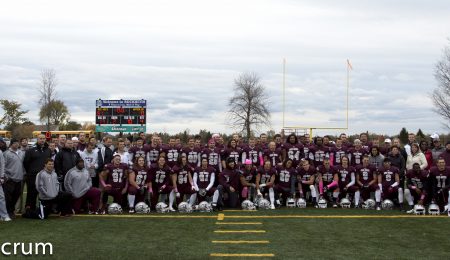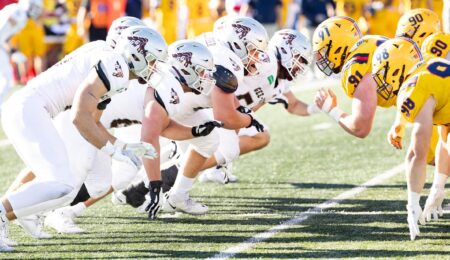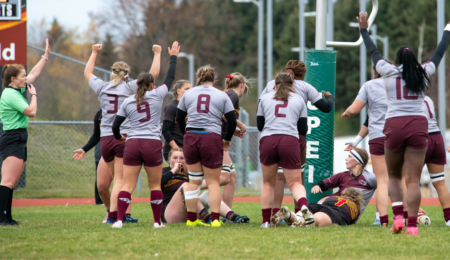When athleticism runs in the family
Spencer Van Dyk | Fulcrum Staff
Twins Myriam and Kelsie English do everything together. Both are third-year social sciences students who plan on becoming elementary school teachers, and both play on the Gee-Gees women’s volleyball team.
In a 2012 study titled “Anything you can do, I can do better,” which detailed the effect of sibling and family influence in sports, researcher Jordan Blazo from The Georgia Southern University concluded that having an athletic older sibling has a positive effect on the social, academic, and athletic ability of younger siblings. As twins, that effect has been even stronger on Myriam and Kelsie.
“You can’t really play volleyball alone,” Myriam said. “So we’d just go in the backyard and play pepper all day, and we play beach together now, so we get to practise there. We have the same goals. We both want to make Team Canada, and we both know what it’ll take to get there, so having someone in your own house wanting the same goal as you, you can’t ask for anything better.”
According to the study, the benefits of athletes living in the same household extended beyond sports to academics, travel opportunities, and social circles. Myriam and Kelsie are an excellent example, sharing classes, a team, and friends.
“We’re best friends, so it’s really easy to get along,” said Kelsie. “It really helps with school. We’ve always got someone to study with. When it comes to friends, we’ve got the same friends, so we’re usually together.”
“We take all the same classes, and we do everything together,” Myriam added. “If people see [either of] us alone, they ask where our sister is. We’re super lucky, because she’s my best friend, and she’s my sister too, so I can go home with her at night, and it’s awesome. We couldn’t ask for anything better. I think that affects us in sports and school.”
Both girls, however, said their relationship has not always been as smooth as it is now. According to the study, there is often a level of competition between athletic siblings that doesn’t exist between regular teammates, and younger siblings especially feel the need to overcompensate to achieve the same (if not higher) skill levels as their older siblings. Myriam and Kelsie said their struggle was not due to an increased level of competitiveness, but rather the blunt nature of communication between siblings.
“With a sister, you’re always going to be more direct,” said Kelsie. “You will tell each other things you wouldn’t tell other people, so that was pretty hard in the beginning, but now it’s not even an issue.”
“When we were in club [volleyball], we clashed a lot,” Myriam said. “We’re willing to tell each other when we see the other make mistakes. I wouldn’t say that to anybody else. We used to have trouble. Now I couldn’t imagine playing without her. I played without her one summer, because she was injured, and I missed her so much.”
Within the study, participants also described their perceptions of their siblings’ achievements, both within sports and in other areas. Participants spoke about the close relationship between them, and how they believed it to be unique compared to their relationships with other teammates. Myriam and Kelsie can certainly relate.
The study also elaborated on the need for support between siblings who play sports together, and how the dynamic can change depending on the sport. In the case of individual sports, whether or not the other sibling was able to attend tournaments affected the relationship. In the case of Myriam and Kelsie, both have always played team sports, but have never played the same position, so perhaps they were not as competitive with each other as other siblings might be.
“I’m not sure we would’ve been as close being different ages,” Kelsie said. “We have a special bond being twins. Had we been playing different sports, I would’ve been happy for her.”
Despite their solid relationship on and off the court, Myriam and Kelsie do strive to impress each other.
“You want to prove something,” Kelsie explained. “You want to do better and push yourself.”
According to the study, being able to form one’s own identity independently of siblings is an important part of the sibling dynamic and helps with achieving a higher academic and athletic standard.
Myriam and Kelsie both said even though they share a team and friends, they also believe their friends see them as individuals.
“[The rest of the team] really considers us as two people,” Myriam said. “Yes, we’re sisters, but we’re also teammates, and they’re not afraid to tell me something even if it’s about my sister. The team is really good for that.”
The English twins aren’t the only successful sibling athletes in the world of Gee-Gees sports. Segun and Telu Makinde run for the track team, Vincent and Julien Campbell represent the Gee-Gees football team, and brother-sister combo Zac and Catherine Traer play basketball.





